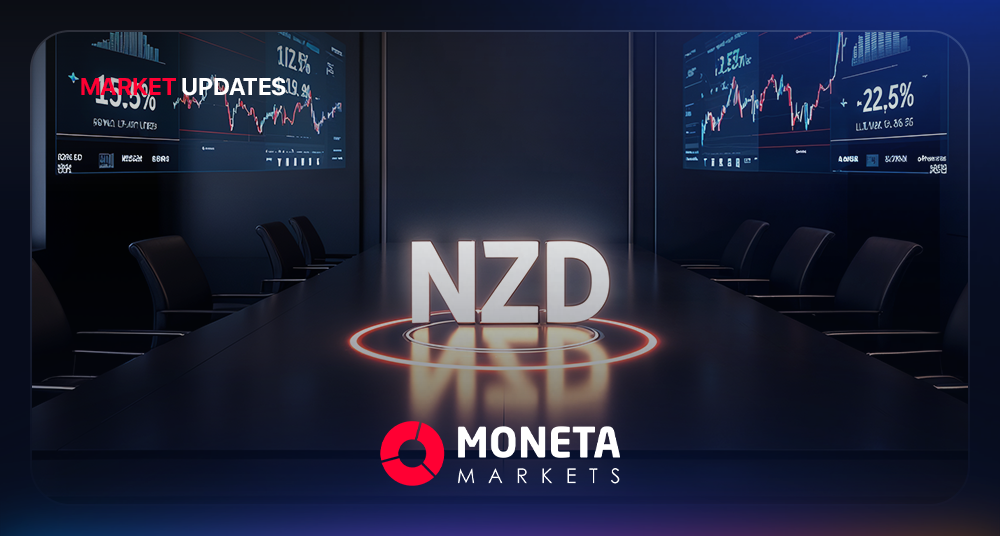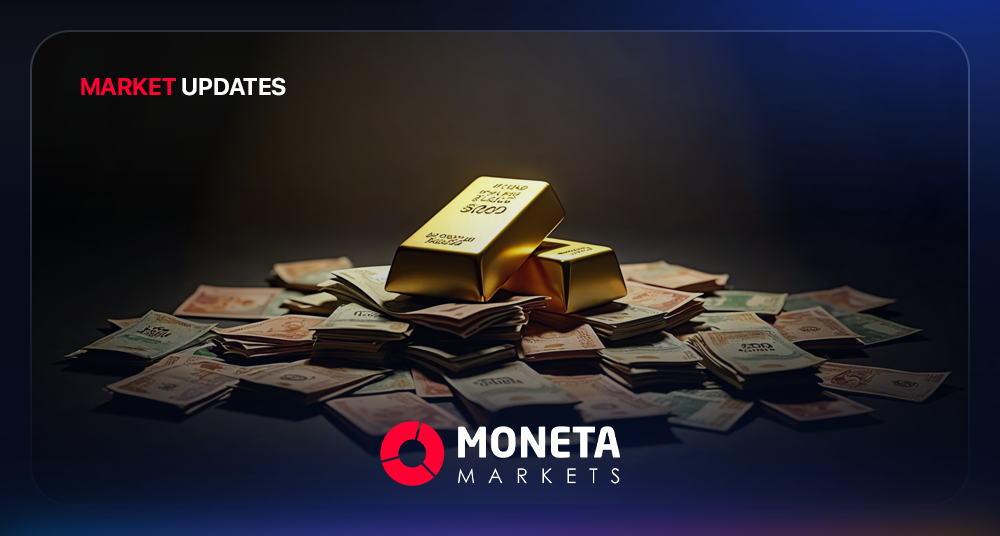Open a live account and start trading in just minutes.
This site uses cookies to provide you with a great user experience. By visiting monetamarkets.com, you accept our cookie policy.
Allow allThis site uses cookies to provide you with a great user experience. By visiting monetamarkets.com, you accept our cookie policy.
Allow all
As global markets continue to adjust to evolving economic conditions, currency pairs and commodities are reacting to shifting risk sentiment, economic indicators, and central bank expectations. Traders are closely monitoring the latest developments in key assets such as the US Dollar, gold, oil, and major currency pairs like EUR/USD and NZD/USD for potential opportunities and risk management.
Gold prices have surged to a record high, with spot gold reaching $3,086 per ounce. This increase is driven by escalating trade tensions following U.S. President Donald Trump’s announcement of a 25% tariff on auto imports, effective next week. Investors are flocking to safe-haven assets like gold to hedge against the uncertainties of a potential global trade war. Analysts suggest that the next target for gold could be $3,100 per ounce, as economic risks and geopolitical conflicts continue to support the bullish trend.
The New Zealand dollar (NZD) is anticipated to continue trading within a defined range against the U.S. dollar (USD). Market analysts project that the NZD/USD pair will remain range-bound, with no clear directional bias in the immediate term. Investors are advised to monitor economic indicators and central bank communications for potential catalysts that could influence the pair’s movement.
The Australian dollar (AUD) is expected to trade between 0.6275 and 0.6320 against the U.S. dollar (USD). Analysts suggest that the AUD/USD pair will likely remain within this range, reflecting a period of consolidation amid prevailing market conditions. Traders should keep an eye on developments in global trade policies and domestic economic data releases for insights into potential shifts in the pair’s trajectory.
The British pound (GBP) experienced a brief uptick following the release of February retail sales data, which showed an unexpected 1.0% increase from January, defying economists’ predictions of a 0.4% decline. This surprising retail performance offered some positive insight into consumer resilience. Following the data release, the pound reached a session high of $1.295, but later settled at $1.2944, showing little overall change. Concurrently, the euro was slightly down against the pound to 83.34. Additionally, the UK economy grew by 0.1% in the fourth quarter of 2024, in line with expectations, and saw a 1.5% annual growth, marginally surpassing the forecasted 1.4% increase.
Global markets are on edge as the implementation of new U.S. tariffs fuels fears of a deepening trade war. Asian stocks have experienced significant declines, with Japan’s Nikkei and South Korea’s benchmark index both dropping around 2%. European and U.S. stock futures also point downward, indicating widespread investor anxiety. The U.S. dollar remains steady ahead of an upcoming inflation report, while the yen has strengthened on expectations of potential rate hikes by the Bank of Japan. Oil prices have seen slight declines due to concerns over the impact of new tariffs on the global economy.

As global markets continue to adjust to evolving economic conditions, currency pairs and commodities are reacting to shifting risk sentiment, economic indicators, and central bank expectations. Traders are closely monitoring the latest developments in key assets such as the US Dollar, gold, oil, and major currency pairs like EUR/USD and NZD/USD for potential opportunities and risk management.
The New Zealand dollar (NZD) has strengthened, trading above the 0.5700 mark against the US dollar (USD). This rise is attributed to a renewed bullish sentiment, with the NZD/USD pair finding initial resistance near the nine-day Exponential Moving Average (EMA) at 0.5750. Technical analysis indicates a strengthening bullish bias, supported by the 14-day Relative Strength Index (RSI) remaining above 50. Key support levels are identified at the 50-day EMA around 0.5717, with potential for further gains if the pair maintains momentum above this threshold.
The Euro (EUR) is experiencing downward pressure against the US dollar, with forecasts suggesting a possible pullback toward the 1.0725 level. This projection is based on technical analysis and current market dynamics, including recent tariff threats by US President Trump and dovish commentary from the European Central Bank (ECB). Traders are advised to monitor upcoming US data releases and Federal Reserve communications for further insights into potential EUR/USD movements.
Gold continues to trade above the $3,000 threshold, supported by a positive risk tone in the market. While bullish conviction appears limited, the metal’s ability to hold above this level reflects ongoing demand amid economic uncertainties. Investors are advised to remain cautious, as market sentiment can be volatile, and geopolitical developments may influence gold’s trajectory.
Crude oil prices are showing bullish momentum as European markets open, driven by factors such as supply concerns and geopolitical tensions. The market is closely monitoring inventory data and OPEC+ production decisions, which are expected to influence price movements in the coming sessions. Traders should stay informed on global demand forecasts and any developments that could impact oil supply dynamics.
Market volatility remains a dominant theme as investors react to ongoing geopolitical developments, inflation concerns, and central bank policies. In the currency market, the US Dollar continues to assert strength against its major counterparts, while commodities such as gold and crude oil remain sensitive to changes in risk sentiment and supply concerns.
In the equity markets, investor focus is on upcoming economic data releases and central bank signals. The outlook for risk assets is clouded by global inflationary pressures, ongoing supply chain disruptions, and the uncertain trajectory of global economic recovery. As central banks worldwide adjust their monetary policies to navigate these challenges, market participants remain cautious, closely watching inflation trends and upcoming policy decisions.

Global markets remain volatile as currency fluctuations and central bank expectations drive investor sentiment. Gold is consolidating above $3,000, while the Japanese yen weakens, and the Australian dollar gains support ahead of the RBA’s April meeting. The EUR/GBP pair remains under pressure near recent lows.
The Japanese yen has depreciated to its lowest level in three weeks against the US dollar. A combination of dovish monetary policy expectations from the Bank of Japan and a relatively stronger greenback has contributed to this decline. However, the lack of follow-through selling suggests that traders are waiting for further cues, including US economic data and any policy shifts from the BOJ.
The Australian dollar is showing resilience as traders anticipate that the Reserve Bank of Australia (RBA) will keep interest rates unchanged in its April meeting. While inflation remains a concern, the RBA has signaled a cautious approach to further tightening, which is providing near-term support for the currency. Market participants are closely watching domestic labor data and global risk sentiment for additional direction.
Gold prices are holding steady above the $3,000 mark, with downside risks appearing limited despite some consolidation. Investors continue to seek gold as a safe-haven asset amid ongoing geopolitical concerns and inflationary pressures. While profit-taking has caused some price fluctuations, strong demand for the metal is keeping it well-supported. Traders are now looking toward US Federal Reserve commentary for potential signals on future interest rate policy, which could impact gold’s trajectory.
The EUR/GBP pair is consolidating above the mid-0.8300s, struggling to regain momentum after touching a three-week low on Monday. The euro remains under pressure due to economic uncertainty in the Eurozone, while the British pound is finding some stability on expectations of a steady Bank of England policy. Market focus is on upcoming economic releases, including UK inflation data, which could influence the pair’s next move.
Global markets remain sensitive to monetary policy shifts and economic data. Equity markets are mixed as investors assess inflation trends, central bank outlooks, and geopolitical risks. The US dollar continues to show strength against weaker currencies, while commodities like gold and oil remain volatile amid supply concerns and shifting risk sentiment.

Global markets are experiencing mixed movements as the US dollar weakens, commodities remain volatile, and investors assess risk sentiment. Gold has pulled back after briefly surpassing $3,000, while oil prices continue to climb amid supply concerns. The NZD/USD pair is facing key resistance, and the dollar index appears vulnerable to further declines.
The US Dollar Index (DXY) has fallen below 104.00, signaling potential further downside. A combination of softer economic data, shifting risk sentiment, and global trade concerns is putting pressure on the greenback. Investors are closely monitoring upcoming data releases for signs of economic resilience.
After briefly touching record highs above $3,000, gold prices have pulled back as risk appetite improves. While safe-haven demand remains a key driver, investors are watching for any shifts in the Federal Reserve’s policy stance that could impact the metal’s outlook.
The New Zealand dollar is attempting to push higher but faces strong resistance near the 0.5750 level, which aligns with its nine-day EMA. A successful breakout could open the door for further gains, but sellers remain active at this level.
WTI crude oil prices continue to rise, supported by strong US demand and geopolitical tensions. With supply risks remaining in focus, oil traders are eyeing further upside, though potential demand slowdowns in major economies could limit gains.
Markets remain sensitive to shifting economic data, central bank policies, and geopolitical developments. Equity markets are showing mixed performance as investors weigh inflation trends and interest rate expectations. Commodities are experiencing volatility, driven by supply chain concerns and shifting global demand. Meanwhile, forex markets are responding to central bank signals and broader risk sentiment. As uncertainty persists, investors continue to seek clarity on growth prospects and potential monetary policy shifts.

Global markets are pulsing with a blend of caution and momentum as economic signals, currency shifts, and commodity trends set the tone. Here’s a rundown of the latest developments shaping today’s market, focusing on gold, the Japanese Yen, silver, and EUR/USD:
The Euro (EUR) against the US Dollar (USD) is falling toward 1.0800, breaking below its nine-day EMA at 1.0880 in early Friday trading. After failing to hold above 1.1000 this week, EUR/USD is shedding gains as the USD rebounds and Fed rate-cut bets stabilize post-FOMC. The pair’s slide from a five-month high of 1.0967 reflects technical weakness and a cautious market mood, with traders eyeing US data for the next spark.
Gold (XAU/USD) is sliding back closer to its overnight swing low, dipping to the $3,030 area during the Asian session on Friday. This pullback is driven by a modest uptick in the US Dollar, with the US Dollar Index (DXY) edging up to 103.85. Despite hitting an all-time high of $3,058 earlier this week, gold’s safe-haven rally is pausing as traders take profits and await further US economic cues, though tariff tensions continue to support its broader uptrend.
The Japanese Yen (JPY) is drifting lower against the US Dollar (USD), with USD/JPY climbing to 148.70 after Japan’s inflation data showed a steady 2.5% CPI for February. While the bullish bias remains intact—bolstered by expectations of tighter Bank of Japan policy—the Yen’s softness reflects a stronger USD and mixed market sentiment. Traders are watching for any hawkish signals from Tokyo to counter this slide, with resistance eyed at 149.00.
Silver (XAG/USD) is flirting with its weekly low, trading just above the $33.00 mark at around $33.10 in the European session. This decline aligns with gold’s retreat and a firmer USD, pressuring the grey metal after it peaked at $34.20 earlier this month. Despite a bullish undertone from safe-haven flows, silver’s momentum is fading, with support at the nine-day EMA ($32.80) now in focus as a potential floor.
Markets are navigating a tug-of-war between a modestly stronger US Dollar and lingering global uncertainties. Gold and silver are cooling off from recent highs as profit-taking kicks in, while the Japanese Yen softens despite a bullish outlook. EUR/USD’s descent underscores USD resilience, with the Fed’s steady 4.25%-4.50% rate stance and tariff jitters shaping sentiment. As risk appetite wavers, the interplay of upcoming US releases and central bank moves will drive the next wave. Ready to trade these market moves? Create an account now and stay ahead of the curve!

Global markets are pulsing with anticipation and mixed signals as economic data, Fed expectations, and commodity shifts steer the course. Here’s a rundown of the latest developments shaping today’s market, focusing on EUR/USD, gold, GBP/USD, and WTI crude oil:
The Euro (EUR) against the US Dollar (USD) is struggling to break decisively above 1.1000, as noted by ING analysts. Trading around 1.0940 in the European session, the pair is facing resistance despite earlier strength that saw it touch a five-month high of 1.0967. A stabilizing USD, post-Fed’s decision to hold rates at 4.25%-4.50%, and mixed ECB commentary are keeping EUR/USD in a consolidative mode, with traders eyeing US data for direction.
Gold (XAU/USD) bulls are retaining control, trading near its all-time peak of $3,056 at around $3,048 during European hours. A flight to safety, fueled by persistent trade tensions and tariff uncertainties, is underpinning the precious metal’s strength. Even with a modest USD uptick (DXY at 103.80), gold’s safe-haven appeal remains intact, keeping it poised for potential new highs as markets digest the Fed’s steady stance.
The New Zealand Dollar (NZD) versus the US Dollar (USD) is extending its losing streak, drifting near 0.5750 despite robust Q4 GDP growth in New Zealand. The Kiwi’s slide to a three-week low reflects a broader risk-off sentiment and a firmer USD, overshadowing positive domestic fundamentals. Technical indicators hint at further weakness, with support at 0.5730 in focus unless global risk appetite rebounds.
WTI crude oil prices are trending bullish at the European opening, rising to $67.50 per barrel from $67.20. This upward move is supported by a weaker USD and lingering geopolitical risks, despite easing Middle East tensions. OPEC+ plans to increase production from April loom as a ceiling, but optimism around China’s demand and US-Canada trade talks are driving WTI’s current strength, with traders watching inventory data closely.
Markets are balancing the Fed’s decision to hold rates steady with ongoing global uncertainties. EUR/USD and NZD/USD are feeling the weight of a resilient USD, while gold shines near record levels as a safe-haven star. WTI crude oil’s bullish tilt reflects a mix of supply risks and demand hopes, contrasting with currency softness. As trade tensions simmer and risk sentiment fluctuates, the next wave depends on US economic releases and central bank cues. Ready to trade these market moves? Create an account now and stay ahead of the curve!

Global markets are pulsing with anticipation and mixed signals as economic data, Fed expectations, and commodity shifts steer the course. Here’s a rundown of the latest developments shaping today’s market, focusing on EUR/USD, gold, GBP/USD, and WTI crude oil:
The Euro (EUR) against the US Dollar (USD) is set for a choppy ride, likely trading between 1.0905 and 1.0970, according to UOB Group analysts. This comes as the pair hovers near 1.0930 in early European trading, pressured by a resurgent USD ahead of the Fed’s rate decision. A softer Greenback earlier this week had lifted EUR/USD to a five-month high of 1.0967, but with the FOMC outcome looming, volatility is the name of the game.
Gold (XAU/USD) bulls are catching their breath after pushing prices to a fresh all-time high above $3,038. Trading around $3,029 in the European session, the precious metal is consolidating as markets await the Fed’s next move, expected to hold rates steady at 4.25%-4.50%. Despite a slight pullback, gold’s safe-haven allure remains strong amid tariff uncertainties and a shaky USD, keeping it poised near the $3,000 mark.
The Pound Sterling (GBP) versus the US Dollar (USD) is expected to edge higher in an uneven fashion, ranging between 1.2955 and 1.3030, per UOB Group. After dipping to 1.2925 last week, GBP/USD is gaining traction near 1.2980, buoyed by a weaker USD and cautious optimism. However, the Fed’s decision and potential US economic slowdown fears could cap its ascent, making for a bumpy ride.
WTI crude oil prices are tilting bearish at the European opening, slipping below $67.00 per barrel from a recent high of $68.34. This downturn follows a volatile stretch, with prices retreating from a two-week peak amid easing Middle East tensions and a stronger USD. OPEC+ plans to ramp up production from April add further downward pressure, though China’s demand outlook offers a faint glimmer of support.
Markets are on tenterhooks as the Fed’s rate decision looms large. EUR/USD’s choppy dance reflects USD uncertainty, while gold holds firm near record territory, signaling safe-haven demand. GBP/USD’s uneven climb contrasts with WTI’s bearish slide, highlighting a split between risk assets and commodities. With the USD Index (DXY) testing 103.70 and tariff talks simmering, the interplay of Fed guidance and global risk sentiment will steer the next wave. Ready to trade these market moves? Create an account now and stay ahead of the curve!

Global markets are alive with volatility, fueled by breaking economic updates, evolving trader sentiment, and commodity shifts. Here’s a look at the hottest developments shaping today’s market, focusing on Trump-related news, oil, CAD, and WTI crude oil:
President Donald Trump’s “Trump 2.0” agenda is ramping up tariff risks, particularly for Europe, as Standard Chartered notes. His push for aggressive trade policies is raising fears of a retaliatory trade war, unsettling markets and driving uncertainty. This development is tilting sentiment toward safe-haven assets as traders weigh the potential economic fallout.
WTI crude oil prices are surging past $68.00 per barrel, reaching a two-week peak amid Middle East tensions and optimism over China’s demand outlook. Trump’s hawkish Yemen stance is amplifying supply concerns, while a weaker US Dollar adds fuel to this bullish run, keeping oil markets on edge.
The Canadian Dollar (CAD) is gaining ground ahead of the February CPI release, expected to show a slight easing in inflation. Rising WTI prices are bolstering the commodity-tied currency, though Trump’s tariff warnings against Canada temper the upside. The CPI outcome could either solidify CAD’s gains or spark a pullback.
Geopolitical pressures are intensifying in the oil market, with ING pointing to Trump’s Yemen policy as a key driver. WTI’s climb above $68.00 and Brent’s push toward $71.00 reflect heightened Middle East risks and a softer USD. China’s economic optimism further supports this uptrend, keeping crude in sharp focus.
Markets are navigating a volatile mix of Trump-driven tariff fears and geopolitical flare-ups. WTI’s surge underscores oil’s sensitivity to Middle East unrest and China’s recovery, while CAD holds firm with an eye on inflation data. Trump’s policies are casting a long shadow, pressuring risk assets and lifting commodity prices. As sentiment wavers, the next moves hinge on US economic signals and global trade developments. Ready to trade these market moves? Create an account now and stay ahead of the curve!

Financial markets are buzzing with activity driven by fresh economic data, shifting sentiment, and commodity movements. Here’s a look at the hottest developments shaping today’s market, focusing on WTI crude oil, the US Dollar Index, EUR/USD, and gold:
WTI crude oil prices are climbing, trading above $67.50 per barrel in the early Asian session. This uptick follows a positive shift in risk sentiment and a rebound in oil prices. Despite ongoing US tariff uncertainties, optimism around US-Canada trade talks and a weaker US Dollar are supporting this recovery, though gains remain cautious as traders eye global demand signals.
The Euro (EUR) against the US Dollar (USD) remains firm above 1.0900, capitalizing on the Greenback’s weakness in early trading. This stability follows a strong run, driven by optimism over Germany’s fiscal plans and a softer USD post-CPI. With the pair near a four-month high, traders are watching for catalysts to push it toward the psychological 1.1000 level or trigger a pullback.
Gold prices (XAU/USD) are edging lower, dipping below the $3,000 mark to around $2,986 in early trading. Despite a year-long surge fueled by trade tensions and Fed rate-cut bets, this slight retreat reflects profit-taking and a modest USD bounce. Gold remains close to its all-time peak, with safe-haven demand still underpinning its broader bullish trend.
The US Dollar Index (DXY) is under pressure, trading around 103.70 during Asian hours, close to its lowest levels since early November. After failing to sustain recent gains, the DXY is grappling with fresh selling amid tariff-related slowdown fears and a high probability of no Fed rate change soon. The index’s vulnerability persists as markets await further US economic cues.
Markets are at a crossroads. WTI crude oil’s rise signals cautious optimism, while the US Dollar Index’s struggles highlight ongoing economic uncertainty tied to US tariffs. EUR/USD’s strength underscores the Euro’s resilience, contrasting with gold’s minor pullback from record highs. As risk sentiment improves slightly, the interplay of US data releases and global trade developments will likely dictate whether these trends deepen or shift. Ready to trade these market moves? Create an account now and stay ahead of the curve!

Financial markets are showing dynamic shifts driven by economic data releases, tariff developments, and currency movements. Here’s a snapshot of today’s key market drivers:
The Pound Sterling (GBP) is softening against the US Dollar (USD), hovering around 1.2925 in the early European session on Friday. This drift lower follows a modest improvement in global risk sentiment, which has slightly eroded GBP’s appeal as a safe-haven currency. Posts on X highlight this pullback, with traders watching closely to see if this signals a broader correction after recent resilience.
The Australian Dollar (AUD) is staging a defense below the 0.6300 level during Friday’s Asian session, bolstered by a brighter risk appetite and a USD lift from US-Canada trade optimism. After shedding losses from three consecutive days, AUD/USD’s recovery remains tempered by ongoing US tariff uncertainties, keeping the risk-sensitive Aussie in a cautious stance.
The US Dollar against the Japanese Yen (USD/JPY) is extending its recovery, climbing from a five-month low of 146.52 to a weekly high of 148.59. Friday’s positive start builds on the aftermath of Wednesday’s US CPI data (headline 0.25%, core 0.27% for February), which hinted at cooling inflation. This rebound suggests shifting momentum, though tariff-related headwinds could still cap gains.
The US Dollar Index (DXY) is finding stability around 103.60 in Asian hours, testing key support near 103.50 after Thursday’s uptick. Following a slide to multi-month lows earlier this week, the Greenback is steadying as markets digest a 95% probability of no Fed rate change on March 19, per the CME FedWatch tool. Yet, tariff-driven slowdown fears keep the DXY on shaky ground.
On March 14, 2025, markets are balancing a fragile US Dollar recovery against lingering economic uncertainties. The GBP/USD’s retreat contrasts with AUD/USD’s tentative rebound, while USD/JPY capitalizes on post-CPI momentum. The DXY’s test of support underscores a market grappling with mixed signals—cooling US inflation offers some relief, but Trump’s tariff policies continue to cloud the outlook. With risk sentiment ticking up, traders are poised for further volatility as the week closes.
Open a live account and start trading in just minutes.
Fund your account using a wide range of funding methods.
Access 1000+ instruments across all asset classes
CFDs are complex instruments and come with a high risk of losing money rapidly due to leverage. You should consider whether you understand how CFDs work and whether you can afford to take the high risk of losing your money. Trading derivatives is risky. It isn't suitable for everyone; you could lose substantially more than your initial investment. You don't own or have rights to the underlying assets. Past performance is no indication of future performance and tax laws are subject to change. The information on this website is general in nature and doesn't consider your personal objectives, financial circumstances, or needs. Please read our legal documents and ensure that you fully understand the risks before you make any trading decisions.
The information on this site is not intended for residents of Canada, Cyprus, France, Spain, Russia, Ukraine, Turkey, Brazil, Malaysia, Indonesia, Italy, the United States, or use by any person in any country or jurisdiction where such distribution or use would be contrary to local law or regulation.
Moneta Markets is a trading name of Moneta Markets (Pty) Ltd, an authorised Financial Service Provider (“FSP”) registered and regulated by the Financial Sector Conduct Authority (“FSCA”) of South Africa under license number 47490 and located at 1 Hood Avenue, Rosebank, Johannesburg, Gauteng 2196, South Africa. Company Registration Number: 2016 / 063801 / 07. Contact Phone Number: +27 (10) 1429139. Operational Office: Unit 7, 31 First Avenue East, Parktown North, Gauteng, Johannesburg, 2193, South Africa.
Mmonexia Ltd, facilitates payment services to the licensed and regulated entities within the Moneta Markets Organizational structure.
Mmonexia Ltd registered in the Republic of Cyprus with registration number HE436544 and registered address at Archbishop Makarios III, 160, Floor 1, 3026, Limassol, Cyprus. Mmonexia Ltd, facilitates payment services to the licensed and regulated entities within the Moneta Markets Organizational structure.
Moneta Markets Limited. Business Registration Number:72493069. Registration Address: Flat/RM A 12/F ZJ 300, 300 Lockhart Road, Wan Chai, Hong Kong. Contact Phone Number: +852 37522556. Operational Office: Unit 1201, 12/F, FWD Financial Centre, 308 Des Voeux Road Central, Sheung Wan, Hong Kong.
Moneta Markets is a trading name of Moneta Markets (Pty) Ltd, an authorised Financial Service Provider (“FSP”) registered and regulated by the Financial Sector Conduct Authority (“FSCA”) of South Africa under license number 47490 and located at 1 Hood Avenue, Rosebank, Johannesburg, Gauteng 2196, South Africa. Company Registration Number: 2016 / 063801 / 07. Contact Phone Number: +27 (10) 1429139. Operational Office: 31 First Avenue East, Parktown North, Gauteng, Johannesburg, 2193, South Africa.
Moneta Markets is a trading name of Moneta Markets Ltd, registered under Saint Lucia Registry of International Business Companies with registration number 2023-00068.
Mmonexia Ltd, facilitates payment services to the licensed and regulated entities within the Moneta Markets Organizational structure.
Moneta Markets PTY LTD soliciting Business from UAE through a Non-Exclusive Introducing Broker Agreement Regulated by SCA , Sterling Financial Services LLC ,Cat 5 ,No 305029